MCN's expert guide to the best motorcycle helmets in 2025, tested for all budgets and bike types

You only have one brain and so it’s important to buy the best motorbike helmet you can afford. That doesn’t always mean spending £1000+ on a race-ready carbon lid, though, and there are plenty of highly-rated budget motorbike helmets that achieve top safety scores, too.
- Are you in America? Find our best helmets USA page here
As far as the law is concerned, the only item of protective kit you are required to wear on a motorcycle is a helmet. There’s a good reason for this, as repeated studies have shown that wearing a helmet can significantly reduce the chance of serious injury (or worse) in the event of an accident.
It’s common sense to look after your noggin anyway, but deciding which is the best motorcycle helmet for you can be a difficult decision, especially with such a vast choice available.
The first place to start is the category of helmet that suits the bike and type of riding you do. There’s no sense buying a feature-packed and well-reviewed motocross helmet to ride your GSX-R1000 at the weekend and an FIM-approved sportsbike helmet won’t necessarily cut the mustard on an adventure bike tour of Morocco.
Types of motorcycle helmets
The core elements of the different types of helmet stay pretty much the same – a hard outer shell with a softer impact-absorbing liner, a chin strap and some kind of viewport – but there are some differing elements and accessories that make some helmets better for specific types of riding or suit the style of the bike you have.
Sporty helmets are aerodynamic and often aggressively styled. They are designed to be stable at high speed and often (but not always) have very high protective qualities due to the speeds reached on track. Sports-touring options take the sportiest designs and add more creature comforts to the mix for long days in the saddle.
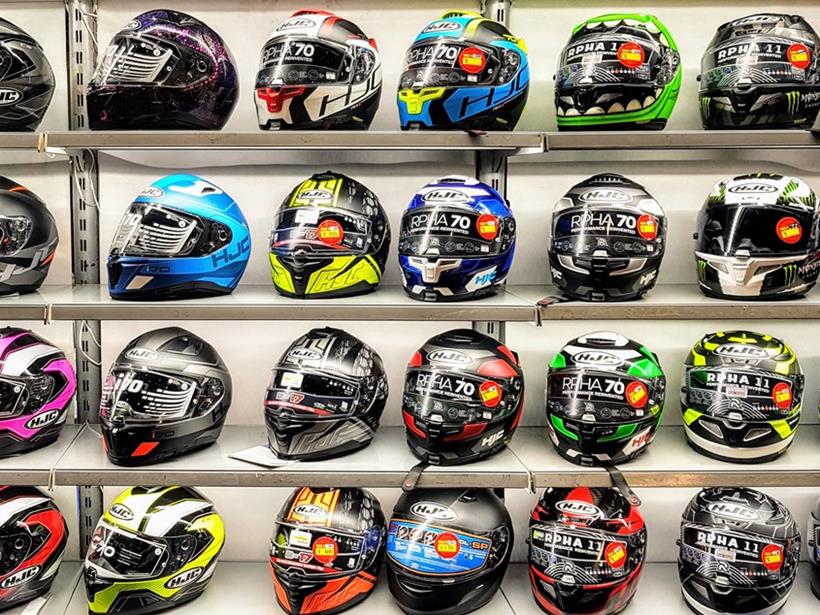
Adventure helmets incorporate a peak to protect from branches or debris and shield your eyes from the sun. Retro helmets borrow their styling inspiration from years gone by but the best incorporate all the latest safety tech under the surface, too.
Flip-front, urban or jet helmets and open face all offer solutions to riding with your face exposed with various levels of safety added.
If you already know what type of helmet you would like then jump to the relevant section here, otherwise read on for more advice.
- Adventure bike helmets
- Sportsbike and naked helmets
- Retro helmets
- Sports-touring helmets
- Flip-front helmets
- Urban helmets
How to choose the right motorbike helmet for you
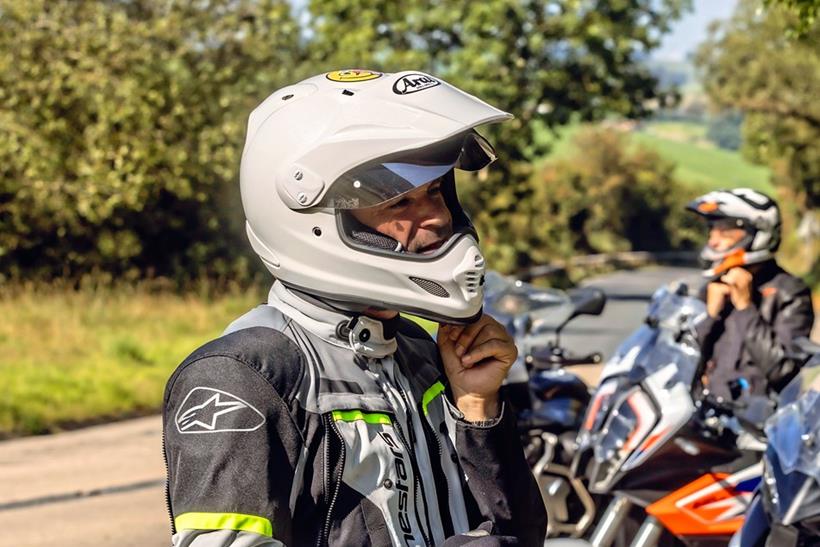
Whichever type of helmet you need, there are some overarching principles that you should keep in mind before you make your choice. Let’s start by looking at the fundamentals and work our way through to options.
A helmet’s primary function is to protect your head from an impact with a solid object. It does this with two main elements – a hard outer shell that is designed to absorb the impact across its entire surface and a deformable inner layer that acts as a cushion or crumple zone. Fibreglass, polycarbonate or carbon fibre are typical materials for the outer construction, whilst expanded polystyrene (EPS) is widely used for the inner.
Many manufacturers incorporate a multi-directional impact system (MIPS) which offers additional protection by allowing the inner to move independently, thus reducing rotational injuries. Some helmets also have an emergency quick-release system (EQRS), which gives emergency services the opportunity to withdraw the cheek pads whilst the helmet is still being worn. This reduces pressure on the head, loosening the fit and making removal easier and safer.
All helmets sold in the UK must comply with the European standard of ECE 22.06, which has replaced the older standard of ECE 22.05 (although old stock of ECE 22.05 helmets will be cleared first).
This involves a whole range of tests to ensure that any given helmet will perform as it should when involved in a crash. You’ll find a tag somewhere on the helmet to confirm this, usually on the chin strap. As of July 2023, all new helmets manufactured have to be tested to the newer ECE 22.06 standard, although it is still legal to wear those tested under the older ECE 22.05 certification.
In 2007, the UK government set up its own testing scheme, the Safety Helmet Assessment and Rating Programme (SHARP). This awards helmets a star rating out of 5 and can give a further indication as to the best motorcycle helmet for you.
Whatever helmet you choose, it’s also worth investing in some earplugs. The wind noise experienced at motorway speed on any bike and wearing any helmet is enough to damage your hearing, so make sure you protect it!
How much should I spend on a motorcycle helmet?
Generally speaking, you get what you pay for when comes to motorcycle kit, and we would suggest buying the best helmet that you can reasonably afford, it is there to keep your head in one piece after all. That said, there are some really good budget helmets out there that offer exceptional value for money.
As mentioned above all helmets must meet a minimum level of safety, so you will usually find that the savings are made in the quality of the finish, weight of the materials used and additional features like intercom readiness.
Watch this video on how to get a helmet that fits correctly:
Adventure bike helmets
At first glance, an adventure bike helmet may appear to be nothing more than a motocross or off-road helmet, but there’s more to them than that. Adventure bike helmets combine the air flow, practicality and sun protection of off-road lids with the creature comforts of sports touring helmets for a globetrotting hybrid.
The most obvious outward element of an adventure helmet is the peak, which comes from the off-road world. It’s there to help keep the sun out of your eyes and also offer a little added protection against branch strikes or other debris.
The down side of a helmet peak is that it creates added turbulence and add strain to your neck muscles on sustained, high-speed rides such as motorway work. For this reason, many adventure helmets also come with blanking panels that let you remove the peak if you wish.
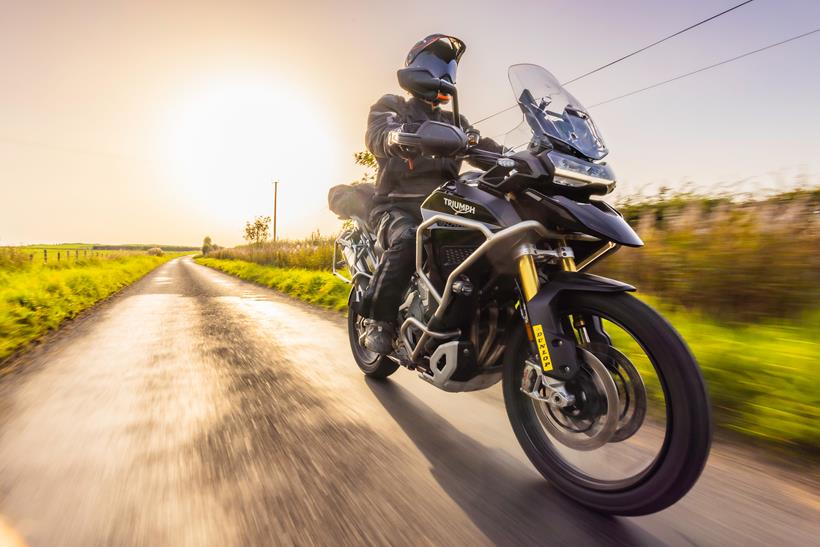
Unlike proper off-road helmets, adventure ones also have the option of goggles or a visor. Wearing googles improves air flow and can keep you cooler when you’re working hard, riding off road, but for road riding the added comfort and protection of a visor is preferable.
Adventure helmets that started out life as off-road models and had road features added are often cheaper than those that were specifically built for the purpose. Here are some of the best we’ve tested on MCN recently:
Which would Product Guru Justin choose between the Arai Tour-X5 or the Nexx X.Wed3?
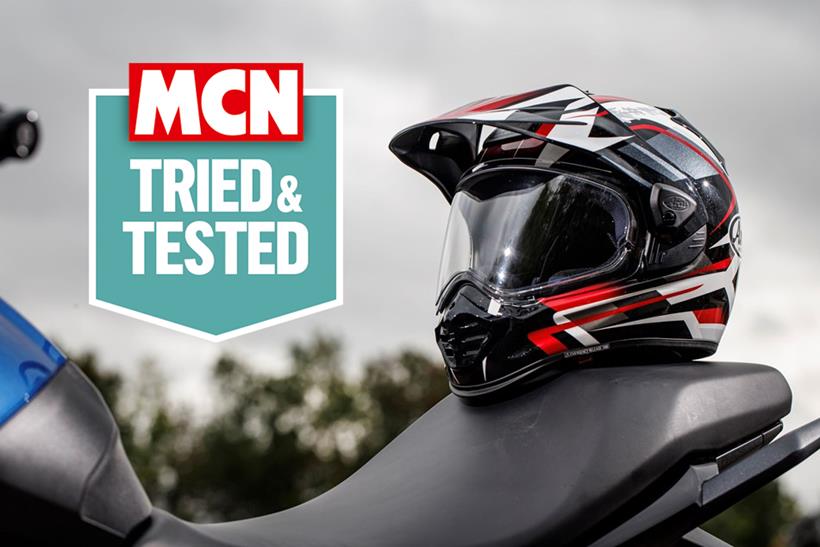

"The Arai Tour-X 5 is a well constructed, comfortable and versatile helmet. It brings together some of the best features of the current range, such as the RX-7’s visor system, Quantic’s logo vent and Profile V’s wider base, along with improvements of its own, to stand as a testament to the company’s commitment to safety through measured evolution.
"With the peak fitted the T-X 5 is ideal for adventure touring, boasting ample room to flip the visor up and wear goggles if needs be, and with it removed makes a smart and practical alternative to a traditional full-face lid. In a previous review I said that the T-X 4 could be the only lid you’ll ever need, but with its quick-change visor, improved shape and enhanced ventilation, the Tour-X 5 takes that versatility to the next level."
Read our full Arai Tour-X 5 review
Pros
- It's really comfortable
- A versatile helmet
- Wide field of vision
- Easy visor change
- Excellent ventilation
- High build quality
- Has an adjustable fit
Cons
- Cheek pads are a little too 'Velcro friendly'
| Weight | 1,700 grammes |
| Construction | Complex fibre laminate |
| Chin strap type | D ring |
| Intercom ready | Yes |
| Drop down sun visor | No |
| Pinlock | Yes |
| Interior | Fully removable, moisture wicking and washable |
| Warranty | 5 years |
| Safety standard | ECE 22.06 |
- Adaptive fit
- Removable peak
- Adjustable peak
- Quick release visor
- Fully removable and washable moisture wicking liner
- Speaker cavities
- Pinlock included
- Adjustable vents
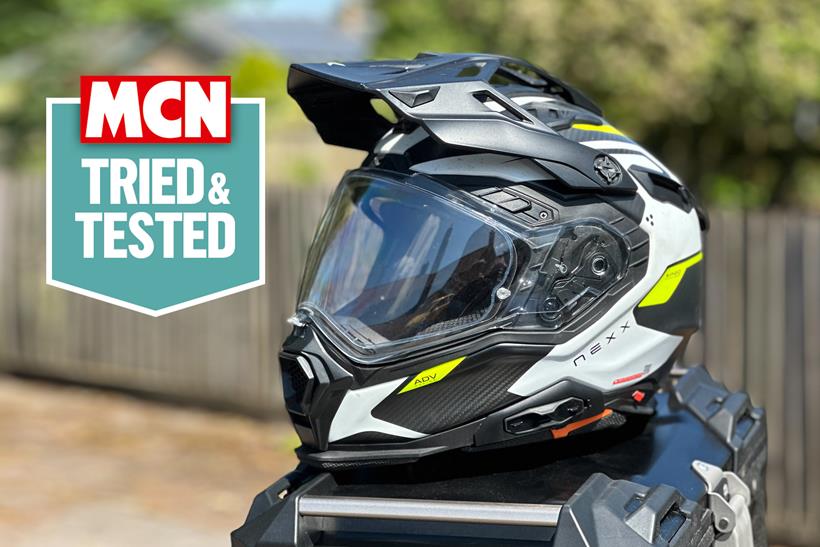

"It’s taken seven years for the latest version of NEXX’s adventure lid to reach the shelves and I was really keen to find out if the wait for the X.WED3 had been worth it? Well, first off, fit is absolutely bang on. I take a medium and it slipped comfortably onto my noggin without any need for adjustment.
"The interior padding is soft to the touch has a plush, cushioned feel to it, with plenty of spring in the foam to keep it snugged against your head without any undue pressure. I’ve spent many a full day riding around the back roads and byways of Norfolk, and it’s barely been off my head for more than then the few minutes it takes to scarf a snack or glug some fluids. I’ve not once felt the need to remove it to give my skull a break.
"The visor mechanism deserves a special mention, in particular the way it locks in the fully open and closed positions. Springs at either side pull its locator lugs firmly into deep detents, which in the open position prevents it from shutting unexpectedly, very handy if you’re on rough terrain and want to maintain maximum airflow, and when closed it increases pressure on the weather seal, effectively rendering it watertight. Despite riding regularly in near monsoon conditions and incessant truck spray on the A47 (such are the joys of a UK spring) it hasn’t sprung a leak anywhere.
"If there’s one thing the X.WED3 is not short of, it’s ventilation. The frontal area has seven separate adjustable vents, and when you have them all open at once, you can literally feel the wind in your hair. The top three have a tendency to whistle, but the intensity varies depending on screen and riding position.
"Skye Boat Song aside, it is noticeably quiet in general use. Construction includes a rubber gasket between the EPS and outer shell designed to soak up any vibrations from turbulent air, and it certainly seems to work. The peak also has rubber mountings to prevent resonance from buffeting.
My only real issue is the weight. It tips our scales at 1.92 kg and that’s a lot of bulk to carry on your bonce. It’s biased towards the front too, causing it to pull your chin down before lift from the peak takes over. Oh, and the chin strap is way too long. This can easily get twisted and cause its padded outer sheath to bunch up under the chin.
"Build quality is of a high standard, and it does feel like a lot of helmet for the money, especially as it comes with goodies such as GoPro mounts and a spare smoked visor. With a five year extended warranty available, the X.WED3 is worth considering for an all round adventure touring lid – as long as you can live with the weight."
Read our full Nexx X.Wed3 review
Pros
- Quiet with or without the peak
- Well integrated comms
- Excellent ventilation
Cons
- Chin strap too long
- Ventilation ports can whistle
| Weight | 1790g |
| Construction | Multi-composite fibre shell |
| Chin strap type | Double D-ring |
| Intercom ready | Yes |
| Drop down sun visor | Yes |
| Pinlock | Yes (included) |
| Interior | Soft anti-sweat and anti-allergic fabric inner lining |
| Shell sizes | 3 (XXS-S, M-L, XL-XXXL) |
| Warranty | Two years |
| Safety standard | ECE 22.06 |
- High-impact carbon fibre shell
- Fast release system allows for easy removal and cleaning of the full interior
- Soft-touch X-Mart Dry fabrics that keep the interior cool and dry
- Synthetic leather lining with large ventilation mesh panels
- Anti-vibration EPS helps reduce turbulent air at high speeds
- X-Foam crash bumpers at the base of the chin and sides help absorb energy in the event of an off
- Removable peak, with 3 levels of adjustment
- Retractable large inner sun visor
- Spring-loaded visor recoil system gives a perfect airtight seal
- Pinlock insert included in the box
- 7 air intake vents and 4 exhaust outlet
- Double D ring strap with magnetic button closure
- Integrated goggle strap holder
- X-COM3 series can be fully integrated into the helmet (not included)
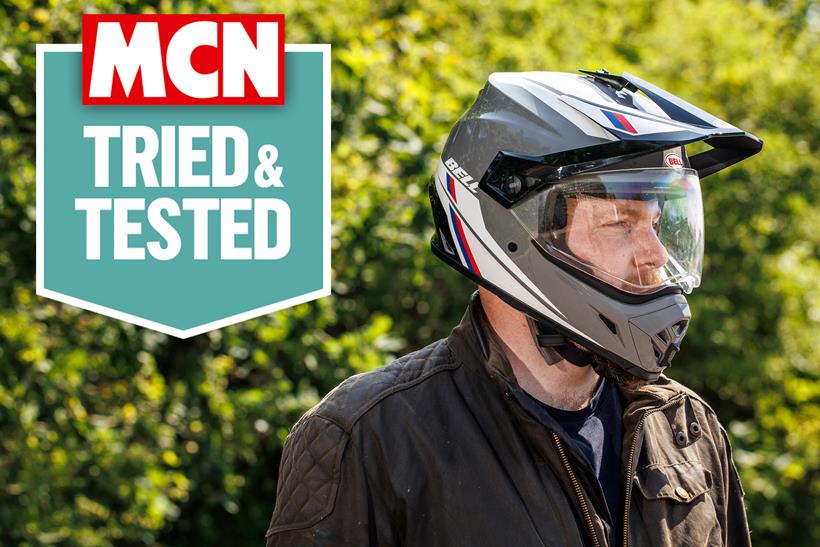

"Straight out of the box I had a 180-mile commute lined up; mostly A road and motorway work, and it was perfect. The only recommendation I can make here, is to make sure you have your screen and wind deflectors aligned correctly to pass over your helmet peak. I tweaked mine on the trip as I went along. If you don’t, the peak can catch the wind and then cause some forward pressure, but that is to be expected if you are caught in heavy buffeting. Once the angles were dialled in it was very peaceful and comfortable."
"Would I buy one for myself? With my own money? In short, yes, no questions asked. I would also seek one out on a deal and use my remaining cash to get some decent goggles to accompany the MX-9 so I had the full suite of configurable riding options for less than £200.00. Can’t grumble at that."
Read our full Bell MX-9 review
Pros
- Good ventilation upfront with easy-to-use chin vent, and wide air flow
- Stiff but comfortable padding, creates a sense of security and quality feel even after several sweat cycles
- Two screw fixing points on top of helmet, with rubber bung to stop dirt ingress when one isn’t used
- High back line, with cut in bottom helmet edge shape, allowing for easier head rotation-
- Wide angle view
- Cheaper helmet but great quality
- Deep paint finish
- Comms ready indentation in internal foam for speakers
Cons
- Lacks top of head ventilation
- Minus points for the lack of sun visor but that is admissible as you can fit glasses behind or drop the visor for a google option
- Runs a little tight on the initial sizing, however, soon breaks in
- A more granular ratchet would be beneficial when you want to crack the face screen just a little. However, anti-fog does work well
- The visor isn’t as secure when it’s used without the peak on
| Weight | 1698G +/- 50G (Size M) |
| Shell construction | Multi-Composite |
| Approval | ECE 22.06 |
| Chin strap | Double-D ring |
| Drop down sun visor | No |
| Pinlock | No |
| Colour scheme | Anthracite |
| Finish | Gloss |
| Form | Adventure |
- Fog free visor
- Removable interior
- 3 Shell and EPS Sizes for a personalised fit
- 5-year warranty
- Intercom ready
Sportsbike and naked helmets
Sportsbike helmets are designed to be as slippery as possible in terms of aerodynamics because they are built to be used at high speeds. This also makes them ideal for use on naked motorbikes where the rider is constantly buffeted by the wind.
Sportbike helmets also have a large field of vision for track use – to improve your view of the riders around you – and also have apertures (the hole you look through) that are high at the top so that you can see where you’re going in a racing tuck.
Many brands have sportsbike helmets right at the top of their range as a flagship model and FIM-homologated versions (which can be used at any level of racing) can run over £1000. But there are plenty of options at lower price points, too.
Here are a couple of sportsbike helmets we’ve rated highly recently:
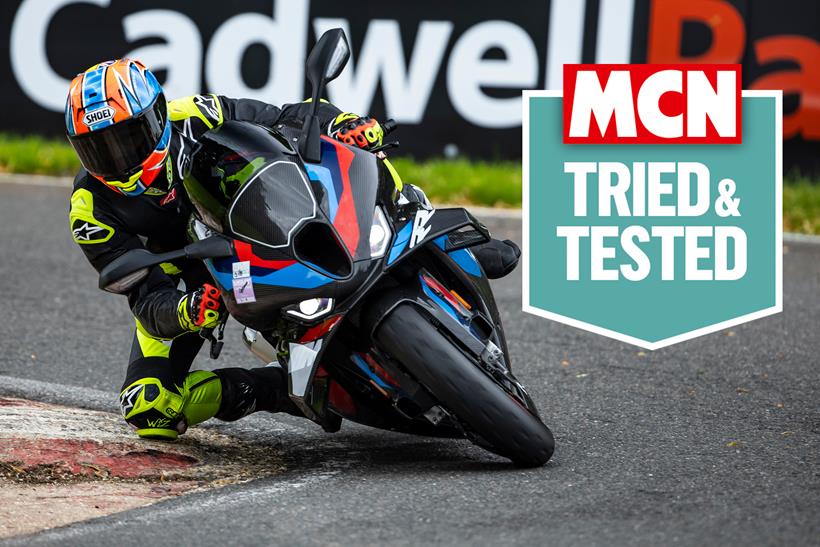

"Shoei’s X-SPR Pro is pricey, but worth every penny. It’s light, comfortable, superbly vented and slips through the air quietly and with complete stability, making it easy to wear for long periods, especially at track speeds.
"I’m a medium and it fits well out of the box, but I’ve taken advantage of Shoei’s Personal Fitting Service, who’ve added extra padding for a perfect fit. It isn’t a service widely available yet but keep an eye on their website for updates.
"It also has a flawlessly applied Rich-Art paintjob. Best of all when you see Marc Marquez consistently walking away from huge crashes wearing a Shoei X-SPR Pro helmet (and the previous versions) it gives you the utmost confidence wearing it."
Read our full Shoei X-SPR Pro review
Pros
- Lightweight and stable, ideal for high speeds and long distances
- Excellent field of vision with high-quality, scratch-resistant visors
- Superb ventilation, especially effective in hot conditions
- Quiet compared to similar racing helmets, reducing fatigue
Cons
- Visor can be tricky to open
- Interior lacks the plush feel of some competitors, such as Arai helmets
- Plastic chin vents can become misaligned and feel less durable
| Weight | 1450g |
| Construction | Multi composite |
| Chin strap type | Double-D ring |
| Intercom ready? | Yes |
| Drop down sun visor? | No |
| Pinlock? | Yes |
| Interior | Fully removable, adjustable and washable |
| Shell sizes | Four shell sizes: XS - XXL |
| Warranty | Five years |
| Sharp score | N/A |
- Removable cheek pads for customisable fit
- Benefits from Shoei's Personal Fitting Service for tailored padding adjustments
- Equipped with multiple vents including double chin vents and three top head vents
- Meets the ECE 22.06 and FIM safety standards


"Following hot on the heels of SHARK’s race-ready Aeron GP, the new Aeron is a motorcycle helmet aimed at road riders who want the top-notch quality and performance associated with its range topping stablemate, minus the adaptive aero and MotoGP-qualifying certification. It still has plenty in common though, such as the aerodynamic Carbon On View and Aramid shell, quick release visor and Optical Class 1 visor, but at a much more palatable price.
"The Aeron is a compact, focused helmet with all the features and functionality required for sporty road or recreational track use. It’s light, comfortable and looks amazing, with a high quality, premium feel to its composite parts – in particular the visor system, which is genuinely a thing of joy.
"For my 100-mile round trip to the office on a naked litre bike you’d be hard pushed to get me in anything else at the moment, not least because I’m besotted with that livery. It may not be as practical as an all-rounder, but then neither are the kind of bikes you’d ride in it."
Read our full Shark Aeron review
Pros
- Very lightweight construction
- Excellent visor system
- Showstopping looks
- Fantastic ventialtion
Cons
- A little too focused for touring
| Construction | Carbon on View and Aramid |
| Chin strap type | D ring |
| Intercom ready | Yes |
| Drop down sun visor | No |
| Pinlock | No |
| Interior | Removable and washable |
| Shell sizes | 2 |
| Warranty | 5 years |
| Safety standard | EXE 22.06 |
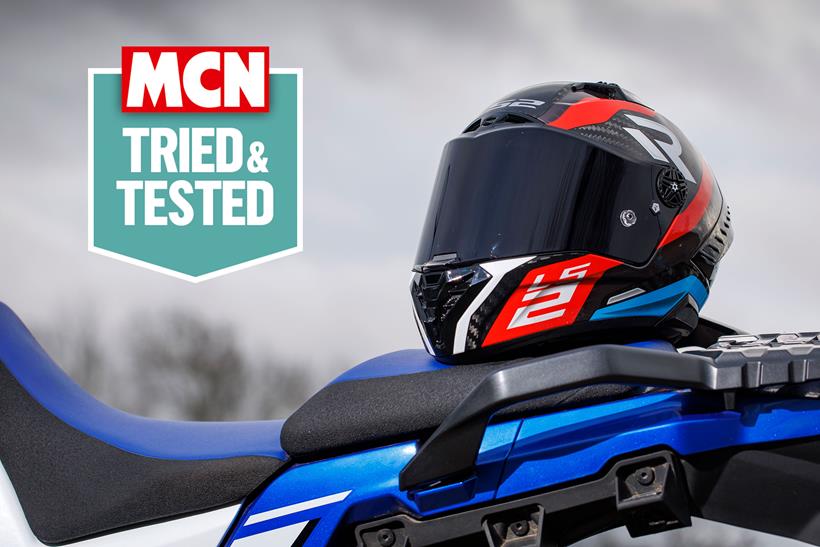

"I would happily recommend the LS2 Thunder Carbon to someone in the market for a reasonably priced sporting helmet.
"It’s comfortable for much of the time and has great vision on the road and track. It’s not the quietest helmet I’ve ever used, even with earplugs in, but it’s not dangerously noisy – you’re just aware that it’s rattling past your ears.
"The vents are easily operated in gloves and they actually make a tangible difference. I just wish they made it in some more colourful designs, and did away with that wheel-like visor mechanism that spoils the look of an otherwise handsome helmet."
Read our full LS2 Thunder Carbon review
Pros
- Impressive field of vision
- Easily operated vents
- Quality finish
Cons
- Styling of visor mechanism
- Occasional pressure
- Limited colour choices
| Weight | 1280g (+/- 50g) |
| Construction | Carbon fibre shell |
| Chin strap type | Double D ring |
| Intercom ready | No |
| Drop down sun visor | No |
| Pinlock | Pinlock Max vision anti fog insert included |
| Warranty | Two years |
| Safety standard | ECE 22.06 |
- Removable, washable, breathable, and hypoallergenic interior
- Wide view, anti-scratch, UV resistant visor with quick release system
- Emergency cheekpad release system
- Large chin and top air intake vents with rear spoiler exhaust ports
Retro helmets
You can technically wear whatever type of helmet you like on a retro bike, but as the scene grew and the market increased, helmet manufacturers sensed an opportunity and many added specific options to their ranges.
Retro helmets range from modern lids with a classic paint job all the way through to hand-crafted custom models that incorporate old-school styling with modern safety standards.
A slight drop in demand has meant that some retro helmet models aren’t being brought up to the ECE 22.06 safety standard and so they will be dropped from ranges, but there are still plenty to choose from.
Here are some of the best we’ve tested recently:


The RSD Saddleback design is now sold out but you can get plenty of other colours and designs like this simple white one.
"For the sorts of bike I like to ride (and the ones I’d put in my own garage) the Bell retro range of helmets fits the aesthetic perfectly. And it’s reassuring to know that they meet the modern safety standards I’d want in an off."
"The Bell Moto 3 is the ideal accompaniment to a scrambler, classic, retro or even a roadster, cruiser or custom and I would happily buy one with my own money. And another, and another."
"The five-year warranty covers the entire recommended replacement interval, too, so I would just get a new one on that cadence and never have to worry about a manufacturing defect ever again. Not that I am worried, because it feels like such good quality that I honestly don’t think there will be a problem."
Read our Full Bell Moto 3 review
Pros
- Looks utterly stunning especially in the RSD Saddleback paint
- In keeping with the style of retro and classic bikes
- Surprisingly quiet despite the lack of visor
- Option for a peak that attaches with sturdy snap fastenings
Cons
- Not a practical choice
- No creature comforts like intercom space
- No drop-down sun visor
- No visor at all!
| Weight | 1417g (L with peak attached) |
| Construction | Fibreglass composite |
| Chin strap type | Double-D ring |
| Intercom ready | No |
| Drop down sun visor | No |
| Shell sizes | S, M, L, XL (three shell sizes) |
| Warranty | Five years |
| Safety standard | ECE 22.06 |
- Snap fastener peak
- Large chin vent
- Roland Sands Design paint job
- Removable and washable soft terry cloth inner liner
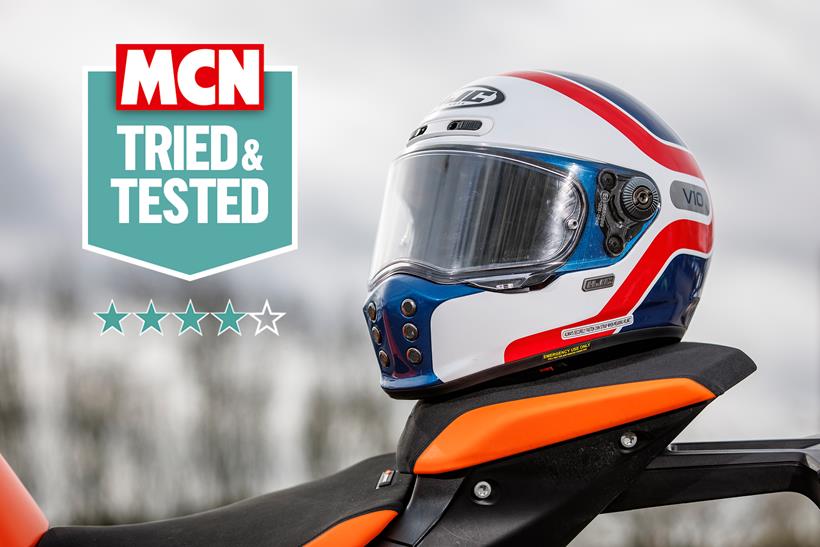

"If the looks are up your street and you’re looking for something to wear predominantly in spring through to autumn, the HJC V10 is a great option. It may not have the lustre and premium feel of more expensive helmets but for the asking price, it’s a really good quality option.
"I wouldn’t feel short changed if I spent my own money on one and when you add in the warranty and the fact the Pinlock is included, it seems an even sweeter deal. I do still have my reservations about using it in very hot weather and will report back later in the year on that front."
Read our full HJC V10 review
Pros
- It's a great looking lid
- Nice retro styling
- It is intercom ready
- It has a good paint finish
Cons
- Visor changes takes time
- It feels slightly budget
- Tight to put on and off
| Construction | Fibreglass shell construction |
| Type | Modern with a retro feel |
| Chinstrap type | Chinstrap type |
| CE Rating | ECE 22.06 |
| Warrranty | 3 years |
- Emergency release cheek pads
- Detachable and washable interior
- Bluetooth compatible with Smart HJC (sold separately)
- Pinlock included
Sports-touring helmets
Sports-touring helmets look similar to sportsbike helmets but put long-distance comfort and practicality further up the pecking order than lap times. You are more likely to find drop-down sun visors, ratchet or seatbelt chin straps rather than double D-ring and integrated intercoms. Aero scoops will also be missing, or at the very least smaller than on out-and-out sportsbike lids.
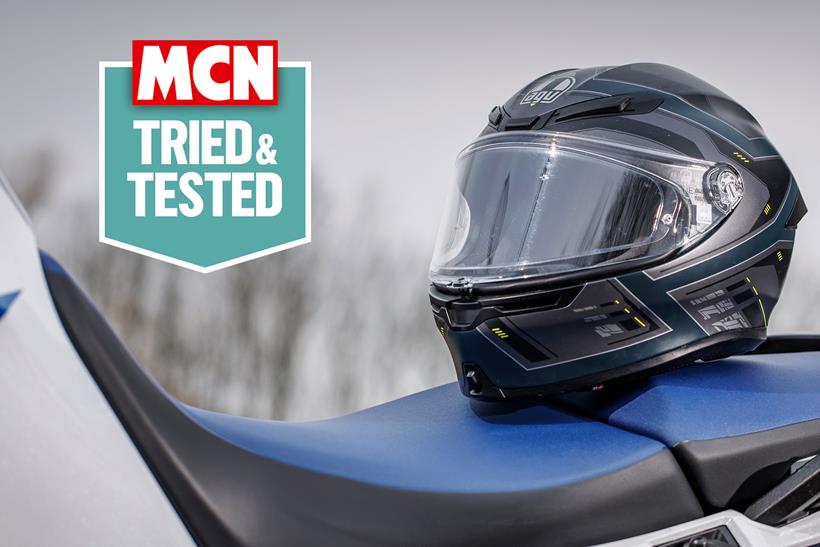

"I try to caveat all helmet reviews with the knowledge that different lids fit different head shapes, but for me AGV is The One. I find the K6 S a joy to use, with low-friction linings that also offer loads of support and moisture-wicking. I don’t have any pressure points to complain about either."
"The visor is fantastic. First and foremost it features 190 degrees of vision, which means you’ve got considerable access to things happening in your peripheral. This makes riding safer. It’s also a tall visor aperture with 85 degrees of vision, meaning no matter if you’re riding an upright adventure bike or a sporty superbike, it’ll suit the riding position."
"This is the best helmet I’ve tested to date. Its incredibly accomplished spec sheet matches with a comfortable fit, light weight and an impressive level of safety."
Read Gareth's full AGV K6 review
Pros
- A lightweight everyday lid
- Four shell sizes
- Comfortable and practical design
Cons
- It's a bit pricey
| Weight | 1600g |
| Construction | Composite fibre |
| Chin strap type | Double-D |
| Intercom ready | Ready for AGV ARK comms system |
| Drop down sun visor | No |
| Pinlock | 100% Max Vision Pinlock (120) included |
| Warranty | 2 years standard, 5 if you register |
| Safety standard | ECE 22.06 |
- Removable and washable interior
- Removable nose guard
- Cheek pads safety release system
- Fit especially designed to allow wearing glasses
- Patented Extra Quick Release System and visor lock mechanism
- Five adjustable front vents and 1 wide rear extractor for optimal airflow
Arai Quantic
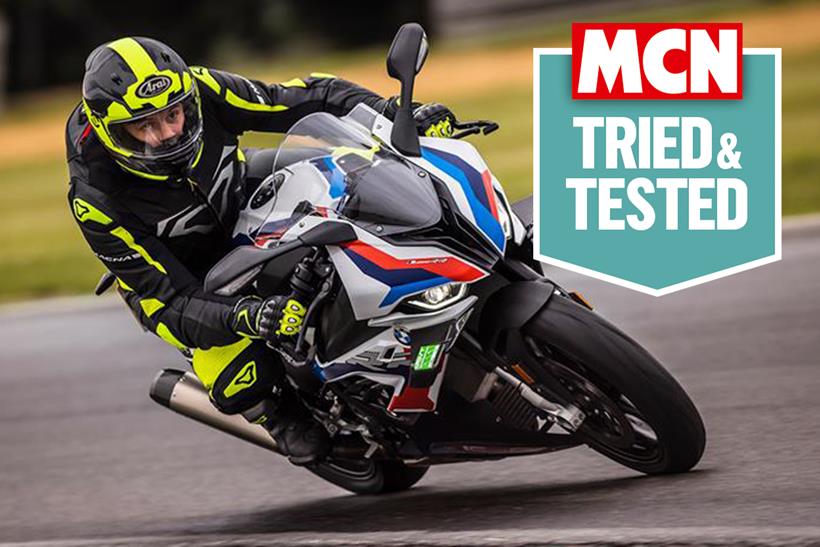

"This Arai Quantic looks on the face of it like a pretty normal helmet. The design looks good but is nothing to write home about and there's a new forehead vent combined with the Arai badge but other than that it looks quite unremarkable.
"Where things get interesting, though, is with the ECE marking on the back (said no one ever but bear with me). That's because the Quantic was the first helmet to meet the new and updated ECE 22.06 safety regulation for helmets – although Shoei weren't far behind with the NXR2.
"At 1600g (large shell size) it's not the lightest helmet out there but this isn't noticeable when you're wearing it. The new ventilation system works really well and keeps you cool even when it's roasting hot. I've used the Quantic on the road and track and it's really quiet, even at very high speeds. At £599, it's not cheap and it's £60 more than Shoei's NXR2."
Read what other MCN testers have to say in our full Arai Quantic review
Pros
- Modern, low-profile design suitable for sports touring
- Exceptional fit and comfort from the first wear
- Features a variety of venting options for increased airflow
- Quiet performance, especially in sporty riding positions
- Built-in recesses for speakers and flat areas for device fitment
- Effective nose and chin visors
- Comes with a Pinlock anti-fog insert and silicone for visor maintenance
- Hand-built in Japan with a high-quality finish
Cons
- Brow vent may produce wind noise in upright positions
- High price point compared to others on the list
- Visor can be tricky to open with thick gloves
- The shell is slightly heavier compared to older models
- Arai don't add anything seen as a 'concession to safety' so no drop-down sun visor, for example
| Weight | 1600g |
| Construction | Peripherally Belted e-Complex Laminate |
| Chin strap type | Double D-ring |
| Intercom ready? | Yes |
| Drop down sun visor? | No |
| Pinlock? | Yes |
| Interior | Replaceable brushed nylon liner material |
| Shell sizes | XS-XL |
| Warranty | 7 years from date of manufacture, 5 from purchase |
| Sharp score | N/A |
- Sliding chin and Arai logo brow vents
- Three-way vent switch in spoiler
- Emergency release system
- Wide range of colours and designs
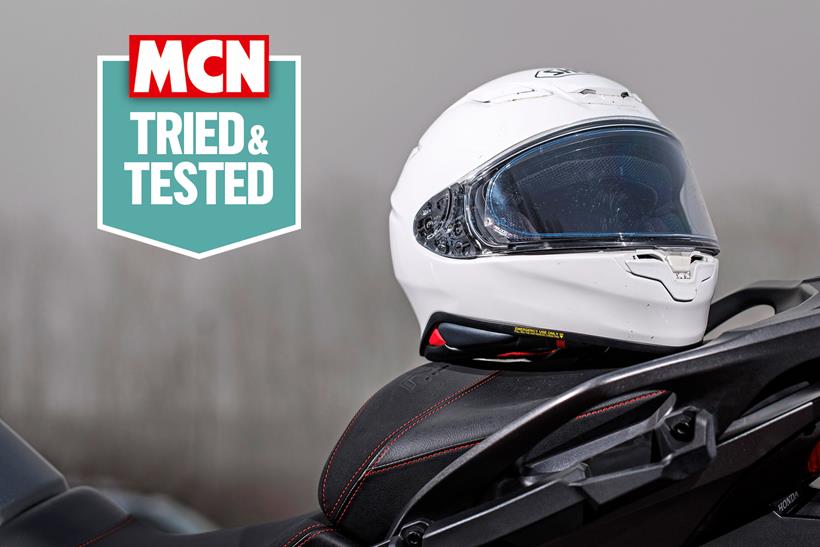

"l think it's a great look, somehow managing to tread the fine line between subtle and stylish, with an aerodynamic twist thanks to the spoiler. But as well as the looks, it's the aeros that make this among the quietest helmets l've worn when travelling at speed. It's versatile in terms of venting too, which has been great for me because I've ridden in all manner of conditions, from frosty drizzle to 40-degree-plus heat.
"A CWR-F2 Pinlock keeps fogging at bay and once I'd learnt to use the vents properly this worked faultlessly. When you're adjusting the vents or indeed operating the visor, you get a real sense of quality in terms of the solidity of the materials and the way they all work together. Inside the shell, the removable liners snap into place with poppers that feel very strong, unlike a lot of cheaper helmets I've tested.
"There are a lot of sizing options, including five outer shell sizes and cheek pads in four thicknesses, which means it's worth getting the helmet fitted properly at a shop rather than buying blind online The strap is secured using a double D-ring and, while l've tried other systems, nothing offers the same simplicity.
"Should the worst happen, there's an Emergency Quick Release System that allows the lid to be removed. Sure, it's not a cheap lid, but if this design is too expensive, there are simpler solid colours on offer starting at a hundred quid less And to top it all off, the Shoei comes with a five-year warranty for additional peace of mind."
Some designs are still 45% off at Sportsbike Shop, making them £289.99 instead of £539.99!
Pros
- Stylish design that balances subtlety and aerodynamics with a spoiler for a quiet ride at high speeds
- Excellent ventilation adaptable to various weather conditions from cold drizzle to extreme heat
- High-quality construction with solid materials that enhance the operational feel of vents and visor
- Available in simpler, less expensive colour options
Cons
- High cost, though justified by the quality and features offered
| Weight | 1470g |
| Construction | Muti-composite shell |
| Chin strap type | Double D-ring |
| Intercom ready? | Yes - Shoei Sena SRL-EXT Bluetooth Communication System |
| Drop down sun visor? | No |
| Pinlock? | Yes |
| Interior | Moisture absorbing Quick-Dry interior for added comfort |
| Shell sizes | XS-XXXL |
| Warranty | Five years |
| Sharp score | 5/5 |
- Emergency quick release cheek pads
- Washable cheek pads, liner and strap cover
- Ventilation system
Flip-front helmets
Flip-front or modular helmets have been popular for decades with riding instructors and police riders who need to speak with people regularly while wearing a helmet. Rather than taking the whole thing off, a button releases the chin bar and allows you to flip open the front of the helmet.
More recently, many flip-front helmets have been dual homologated, meaning you can ride with them either open or closed. This means you get the cooling comfort of an open face in town and the safety of a full-face when you hit the national speed limit.
Flip-front helmets are also popular with touring riders who enjoy the ease of flipping the front for chatting with a pillion or buying fuel.
The down side of a flip-front helmet is that they tend to be larger and heavier than a full-face due to the inclusion of the mechanism (although they get better every year). They also tend to feature the more basic colour and design options.
Here are some of the best flip-front helmets we’ve tested recently:
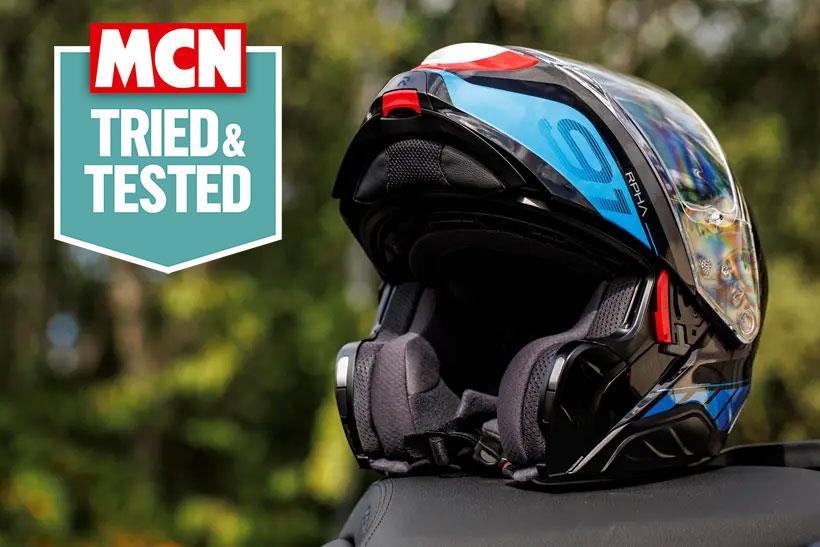

"I would strongly recommend this lid, if you are looking for a good quality, comfortable and feature packed flip-front. Flip-front lids are great for touring, and I’ve worn loads over the year. I headed out on a 1600 mile round trip for the first wear of this lid, that is the confidence I had in the brand and I wasn’t disappointed. Padding is soft and plush, it shows no signs of wear plus it’s retained the new helmet smell, even after sweating, getting stuck in torrential rain and riding for ten hours a day.
This has all the practical elements that I’ve come to expect. The drop-down sun-visor is easy to operate, via a lever on the left underside of the helmet and the visor is sufficiently tinted to be of use. There’s a Pinlock anti-fog insert, which is essential for year-round riding."
Read our full HJC RPHA 91 review
Pros
- It's comfortable from the off
- Offers good ventilation
- Has shown no signs of wear so far
Cons
- It is quite pricey
| Weight | Unknown |
| Construction | Carbon-aramid hybrid and natural fibre shell |
| Chin strap type | Quick release |
| Sizes | XS, S, M, L, XL, 2XL |
| Warranty | 5 years |
| Safety Standard | ECE 22.06 |
- Flip-front helmet with full front-to-back airflow
- Pinlock anti-fog insert
- Anti-scratch coated visor
- Drop-down sun visor
- Glasses grooves
- Removable and washable interior
- Quick release closure
Schuberth E2
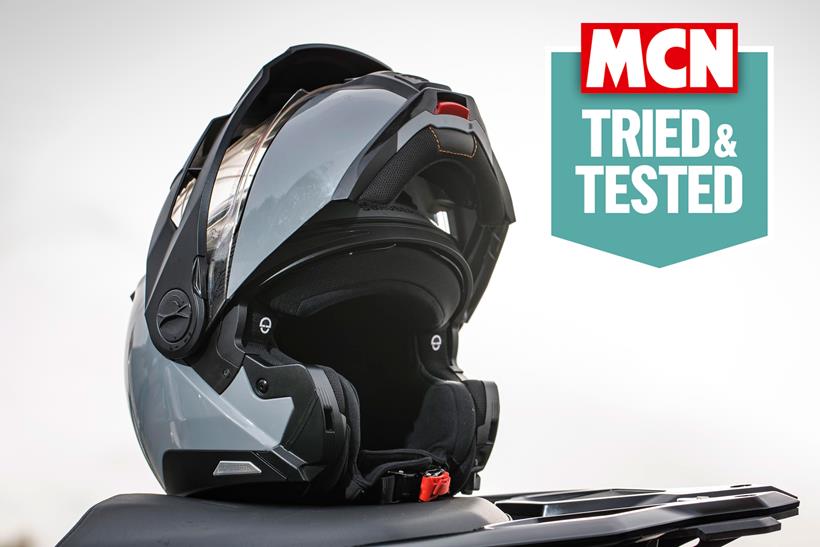

"This is a high-quality, feature-rich lid with plenty to recommend it as an ownership proposition, including a brilliant comms system integration and the five-year warranty. It isn’t perfect; I’d like slightly higher quality-feeling materials for the money, but overall I don’t think you’ll be disappointed.
The marketing bumpf does claim superior aerodynamic properties for this lid, and they claim it’s very quiet, but in fairness this is borne out by my experience. It’s a quiet helmet at most speeds, and clearly the design features a number of attributes aimed at smoothing airflow. As you’d expect for a lid with integrated communications systems, they perform flawlessly, with perfect sound quality for listening to music or using the phone."
Read our full Schuberth E2 review
Pros
- It has loads of features
- It is comfortable
- Prepared for impressive comms system
- Comes with a five-year warranty
Cons
- Quality of some materials leaves a little to be desired
| Weight | 1695g (or 1850g with comms system) |
| Construction | Composite |
| Chin strap type | Quick release |
| Intercom ready? | Yes |
| Drop down sun visor? | Yes |
| Pinlock? | Yes |
| Interior | Removable |
| Shell sizes | XS, S, M, L, XL, 2XL, 3XL |
| Warranty | Five-year |
| Safety standard | ECE 22.06 |
Urban helmets
If you never venture out of the city centre or ride a scooter to work, an open-face or jet helmet could be a comfy alternative to a full-face.
These are more popular in the scooter culture of mainland Europe’s cities but plenty of UK riders also wear them. Open face helmets are also popular for cruiser or American bike riders and also classics and retro bikes.
Although comfy to wear and cool in hot weather, the obvious down side is that your face isn’t protected in a crash – although jet helmets usually extend further down the jaw line.
Shoei J-O
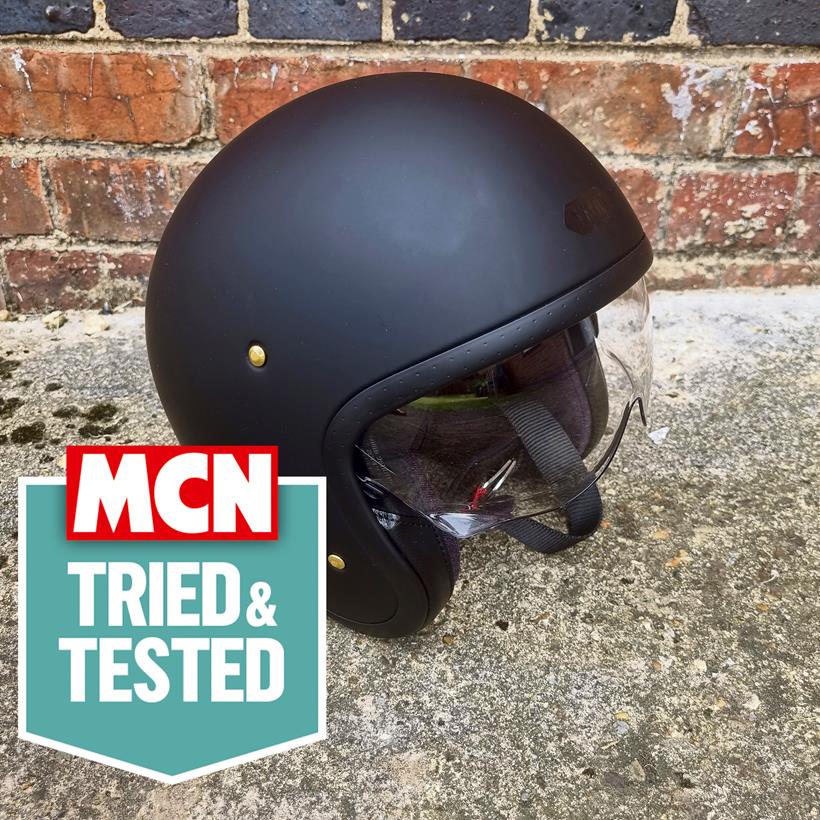

"Before I tested this helmet, I’d never worn an open-face. But, since I was touring America in the middle of summer, I opted to give it a go.
"The lack of a chin bar meant I felt a little exposed, but this sensation quickly disappears when you’re on the ride. Plus, the J-O’s composite fibreglass shell is made from the same blend of fibres Shoei uses on its top-spec racing helmets and it features the same kind of multi-density EPS.
"I think it’s a classic and understated design, particularly its low-profile shell shape, as some other open-face helmets can give you a ‘lightbulb head’. The clear visor with its three-levels of closure meant I didn’t have to invest in goggles and gives that extra bit of protection from the wind – as well as being vital in the rain!
"I also like that the J-O has a double-D ring chin strap. There’s no drop-down sun visor but the fit is comfy enough for me to be able to pop on a pair of sunnies. It is fabulous in warm weather and would be great for city riding too"
Pros
- Made with a composite fiberglass shell, similar to Shoei's high-spec racing helmets, ensuring robust protection
- Classic and understated design with a low-profile shell shape that avoids the common 'lightbulb head' look of some open-face helmets
- Equipped with a clear visor that has three levels of closure, eliminating the need for goggles and providing protection from wind and rain
- Includes a double-D ring chin strap, which is a preferred secure fastening method for many riders
- Excellent for warm weather and ideal for city riding due to its open-face design and ventilation
Cons
- Lack of a chin bar may leave the rider feeling exposed, which could be a concern for those used to full-face helmets
- Does not include a drop-down sun visor, which might be a drawback for some users who prefer built-in sun protection
| Safety rating | ECE 22.05 |
| Construction | AIM glass fibre and organic fibre shell |
| Chin strap type | Double D ring |
How do I choose the right size motorbike helmet?
A correctly fitting helmet is paramount, both in terms of safety and comfort. Too loose could cause it to move around in use, and it won’t be able to protect as it should, maybe even coming off in an accident. Too tight, and it will quickly become uncomfortable, affecting concentration and giving you a headache – a few miles in a helmet that’s too small can be akin to a medieval torture device. The best motorcycle helmet should be just snug, moving with your head without causing discomfort.
Measuring your head is a good place to start in finding your size (above the ears and around the forehead), but the only way to be sure is to go to a shop or show and try some on. Manufacturers offer a range of shell sizes to suit different size heads, as well as liners and cheek pads to achieve a full custom fit. The best motorcycle helmet is the one you feel most comfortable wearing.
FAQs
-
What's the best type of strap?
Keeping a helmet in place is crucial to its effectiveness, and there are three main types of fastening systems - double D-ring, ratchet clasp or a car seatbelt style clip and catch. All meet the required standard, so ultimately it's down to personal choice.
A double D-ring is the traditional method and is adjusted each time it's fastened by simply tugging it snug. With no moving parts, it's also the simplest and remains the standard at the top level of bike sport. A ratchet clasp is similar in that you tighten it to suit every time, but some will find feeding the strap through the clasp less fiddly to get the hang of. The seat belt type has to be adjusted first, altering the length of the strap to suit, so may involve some trial and error. In operation, it's a simple case of clipping the buckle into the catch and pressing a button to release.
A strap is correctly tightened when you can slip two fingers between it and your jaw. Any more than that could restrict breathing or blood flow, any less and your helmet may not stay on when it needs to. -
Which helmets are rated by MCN?
MCN's expert road testers have a wealth of experience in testing every aspect of motorcycle kits and have put a huge variety of helmets through their paces. Here's our pick from each category - you can find more options plus in-depth reviews by clicking on the relevant links.
How MCN tested these helmets
At MCN, our team of expert journalists have decades of experience gained over hundreds of thousands of miles. We don’t test our kit to destruction; we use it exactly how you do, in the real world and in all conditions. That means we can deliver impartial buying advice you can rely on.
Each of our writers has an in-depth understanding of the needs of today’s biker… because they are one.
We’ve worn these tested helmets for hundreds or thousands of miles on MCN test bikes and we ride in all weathers and conditions, too. We’ll never recommend a helmet we wouldn’t put our own head in!
If you can’t see a review against a helmet on this page, it’s because we haven’t tested it yet. These helmets will only be included if we think they’re important and relevant in the market, and rest assured, we will be working on bringing you a review as soon as we’ve done the miles.
To find out more about our kit testing, head to our dedicated page explaining how we test motorcycle products.
About the testers
Justin Hayzelden – MCN’s Products Editor and resident bike kit guru, Justin has covered hundreds of thousands of miles on two wheels both at work and in his personal life. In this page, he tested the Arai Tour-X 5 and Nexx X.Wed3 adventure helmets.
Michael Neeves – MCN Chief Road Tester, ‘Neevesy’ has ridden almost every new bike for more than a decade on multiple continents. He needs kit he can trust to do the the job – whatever the conditions. For this page he tested the Shoei X-SPR Pro.
Ben Clarke – Deputy Head of Digital, Ben has worked at MCN since 2018 testing bikes and kit every opportunity he gets. For this page he tested a Bell Race Star DLX Flex, Shoei Ex-Zero, Arai Quantic and HJC V10.
Gareth Evans – Head of Digital, Gareth made the switch from four wheels to two in 2019 and has never looked back (apart from when he’s racing classic cars…). For this page he tested the Shoei NXR2.
Saffron Wilson – Staff Writer, Saffron covers thousands of miles in all weathers getting the latest news and features for the paper. For this page she tested a Shoei J-O.
Our scores explained
When we review a product, we award it a score out of five. In the ratings tab of a given product, you may also find more specific scores for the different aspects of a product’s performance to help you make an informed decision. Here’s a guide to what each number score means:
- 1 star – Poor performance in this category or overall. A product with a single star rating has fallen below the expected standard and should be avoided.
- 2 stars – Basic performance in this area or overall. A product with a two-star rating has managed to perform to a barely acceptable level and there is room for improvement.
- 3 stars – An average performance in this area or overall. A product with a three-star rating has achieved a basic level of performance and is deemed adequate.
- 4 stars – A product has performed over and above the accepted averaged in this category or overall. A product with a four-star rating has surpassed expectation and delivered in a particularly impressive way.
- 5 stars – A product has performed at the highest possible level in a particular category or overall. A product with a five-star rating has delivered to the highest possible level, impressing the tester with its performance. We would happily spend our own money on it.
- Just so you know, we may receive a commission or other compensation from the links on this website - read why you should trust us.









